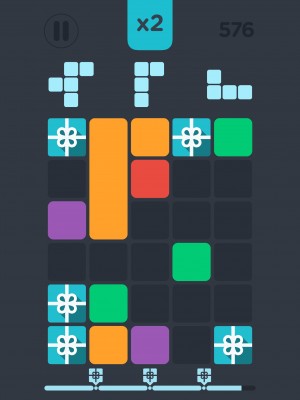Sometimes games have the hallmarks of greatness, but fail to stick the landing, and that’s how I perceive Joinz ($1.99) to be. It mixes Tetris with Threes ($5.99), having players form tetrominos and other block shapes by sliding different-colored blocks around the board, with same color blocks sticking to each other. As more matches are made, powerup blocks come into play, and more colors get involved, making the game steadily more challenging. But it’s the way that the game starts and then increases its difficulty, along with a qualm with randomness and the logic of blocks sticking together that keep it from really reaching its potential.
 Joinz starts off by matching just one color, and this is really quite the boring way to start playing, because it’s only half of the game, just trying to make shapes with blocks. It’s practically impossible to fail in this early-game scenario. The game really doesn’t get going at all until the second color of blocks comes into play, and suddenly the conflict comes in. Now the game becomes about finding ways to use the different colors of blocks with each other to make matches possible while not blocking anything in becomes important. I feel like the game should start with two colors in play, because it would be a lot more interesting than it is now, and would make starting new games much less of a mountain to climb. It’s not that bad, but it’s still annoying. Didn’t we learn from Dong Nguyen’s games that difficulty curve is for suckers in simple games? Start out challenging and interesting from the word go!
Joinz starts off by matching just one color, and this is really quite the boring way to start playing, because it’s only half of the game, just trying to make shapes with blocks. It’s practically impossible to fail in this early-game scenario. The game really doesn’t get going at all until the second color of blocks comes into play, and suddenly the conflict comes in. Now the game becomes about finding ways to use the different colors of blocks with each other to make matches possible while not blocking anything in becomes important. I feel like the game should start with two colors in play, because it would be a lot more interesting than it is now, and would make starting new games much less of a mountain to climb. It’s not that bad, but it’s still annoying. Didn’t we learn from Dong Nguyen’s games that difficulty curve is for suckers in simple games? Start out challenging and interesting from the word go!
Now, because the game draws inspiration from Threes, there might be some contrasting with that game’s early-game state. Certainly, it’s difficult to fail when there’s 3s and 6s on the Threes board. But the game is all about that one core conflict, of trying to get the proper tiles together, and it always starts by engaging players with its core conflict, and then building on it. The early game isn’t necessarily boring, there’s always something there to test the player. It’s okay to start slow and ramp up, but there’s a difference between how slow Joinz ramps up at and Threes‘ speed.
 But, Joinz really does manage to get good once it gets going. There’s a certain tension that comes from trying to plan out just the right moves to make the necessary shapes, and dealing with the randomness that comes in. I feel like some sort of indicator showing what is coming next would be useful, as otherwise it’s just chaos. Randomness is fine when there’s rules to guide it. But still, finding ways to use differently-colored blocks to help form the more complicated shapes is satisfying. The powerups serve dual uses: they can be blockers to help form shapes, along with their intended usage as, well, powerups. And more advanced powerups become available as the single game goes on, increasing the strategic depth, but also making it such that choosing what to use becomes a difficult choice.
But, Joinz really does manage to get good once it gets going. There’s a certain tension that comes from trying to plan out just the right moves to make the necessary shapes, and dealing with the randomness that comes in. I feel like some sort of indicator showing what is coming next would be useful, as otherwise it’s just chaos. Randomness is fine when there’s rules to guide it. But still, finding ways to use differently-colored blocks to help form the more complicated shapes is satisfying. The powerups serve dual uses: they can be blockers to help form shapes, along with their intended usage as, well, powerups. And more advanced powerups become available as the single game goes on, increasing the strategic depth, but also making it such that choosing what to use becomes a difficult choice.
I will say that there are a couple of baffling choices, though: if a match is made by launching a block into another, it’s automatically removed, which makes removing more complicated shapes a bigger challenge than it ought to be if two shapes are similar. Otherwise, making a match isn’t removed until tapped. Some consistency would be welcome. Additionally, the game doesn’t resume if the app gets closed, which is unacceptable in 2014, especially considering the potential length of game sessions.
I really think Joinz is a flawed game, but I think the moments where it’s in its groove are really, really good. That strategic tension of trying not to make the one fatal screwup is a hallmark of great games. It just makes a few missteps along the way to being great.
